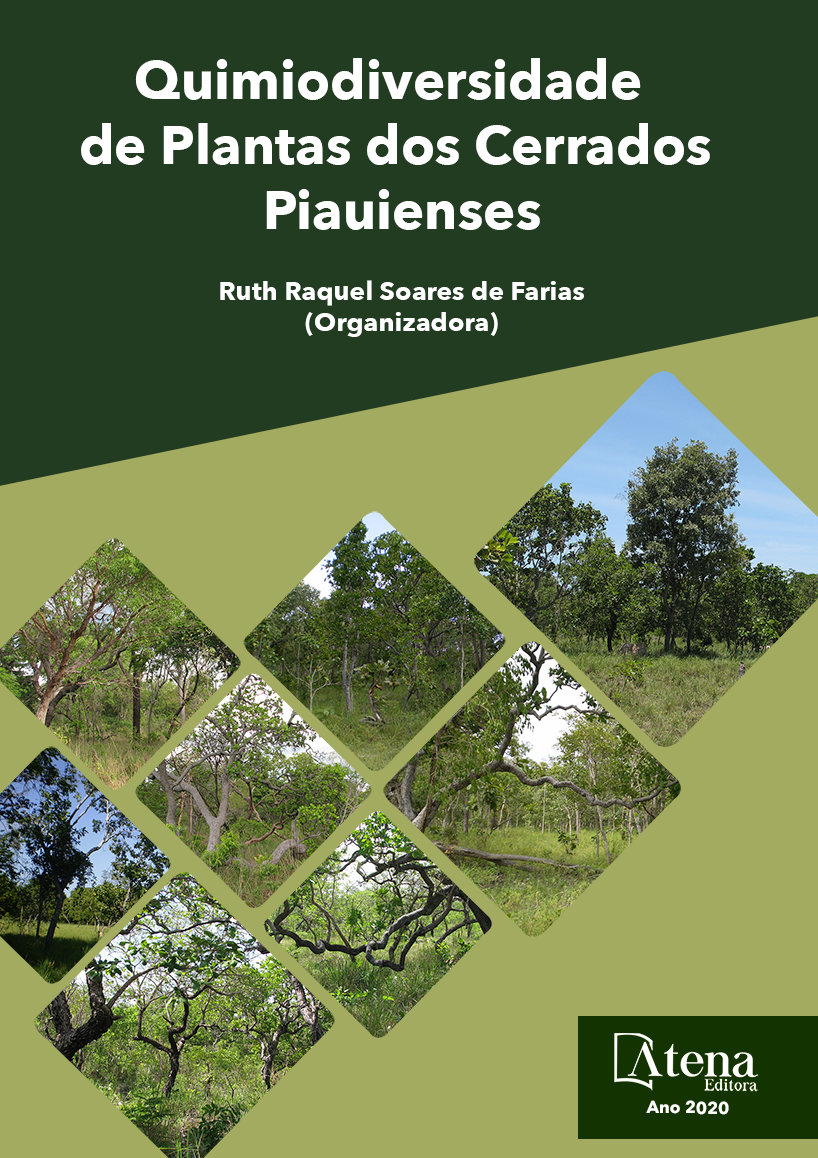
PERFIL FITOQUÍMICO DE ATIVIDADES FARMACOLÓGICAS DE Combretum mellifluum EICHLER DE DUAS ÁREAS DE CERRADO
O presente estudo relata
variabilidade fitogeográfica, química e
farmacológica dos extratos hexânico, etanólico
e aquoso das folhas da espécie Combretum
mellifluum Eichler. como contribuição para
a caracterização química e farmacológica
dos Cerrados Setentrional e Meridional do
Piauí. O perfil químico dos extratos foi obtido
por cromatografia líquida de alta eficiência.
A atividade antioxidante foi avaliada pelos
ensaios dos radicais 2,2-difenil-1-picrilhidrazila
(DPPH), hidroxila e óxido nítrico, substâncias
reagentes ao ácido tiobarbitúrico (TBARS)
e redução do Fe3+ à Fe2+. A determinação
do teor de fenóis totais foi realizada pelo
método de Folin–Ciocalteu e de flavonoides
totais por redução com cloreto de alumínio. A
atividade anticolinesterásica foi investigada
pelo método de Ellman e a citotoxicidade pelo
método de brometo de 3-(4,5dimetildiazol-
2-il)-2,5difeniltretrazolium (MTT), frente a
linhagens de células tumorais humanas (cólon,
ovário e glioblastoma). O extrato aquoso C.
mellifluum (Meridional) apresentou atividade
antioxidante (CE50 46,50±1,43 mg/mL) maior
do que o controle rutina no ensaio do DPPH. O
extrato aquoso de C. mellifluum (Setentrional)
apresentou alta atividade antioxidante na
redução dos radicais oxido nítrico (0,47±0,11
mg/mL) e hidroxila (0,76±0,13 mg/mL). Os
extratos hexânicos e etanólicos exibiram
resultados positivos para o teste qualitativo
de inibição da acetilcolinesterase. O extrato etanólico (Setentrional) foi fortemente
ativo frente as três linhagens de células OVCAR-8 (carcinoma de ovário), HCT-116
(colonretal – humano) e SF-295 (glioblastoma – humano), com percentuais de inibição
de 95,87±0,32; 83,89±1,39; 89,00±1,18 respectivamente. Os extratos etanólicos e
aquosos apresentaram alto teor de fenois e flavonoides totais. A análise dos perfis
cromatográficos mostraram a variedade química, evidenciada também pela diferença
na resposta das atividades biológicas dentro de uma mesma espécie.
PERFIL FITOQUÍMICO DE ATIVIDADES FARMACOLÓGICAS DE Combretum mellifluum EICHLER DE DUAS ÁREAS DE CERRADO
-
DOI: 10.22533/at.ed.3482005032
-
Palavras-chave: Biodiversidade. Cerrados do Nordeste. Variabilidade Química.
-
Keywords: Biodiversity. Cerrados of Northeast. Chemistry variability.
-
Abstract:
This study reports for the first time the phytogeographic, chemical, and
pharmacological variability of hexane, ethanolic and aqueous extracts from leaves of the
species Combretum mellifluum Eichler. as a contribution to the chemical characterization
of the Northern and Southern cerrado of Piaui. The chemical profile of the extracts was
obtained by high-performance liquid chromatography (HPLC). The antioxidant activity
was evaluated by the test of the radicals 2,2-diphenyl-1-picrylhydrazyl (DPPH), hydroxyl
and nitric oxide, reactive substances to thiobarbituric acid (TBARS), and reduction of
Fe3+ to Fe2+. The determination of total phenolic and flavonoid content was performed
by the method of Folin-Ciocalteu and by reduction with aluminum chloride, respectively.
The anticholinesterase activity was performed by Ellman’s method. The cytotoxicity was
measured by MTT cell proliferation assay against human tumor cell lines (colon, ovary
and glioblastoma). The aqueous extract of C. mellifluum (Southern) presented higher
antioxidant activity (EC50 46.50±1.43 mg/mL) than the routine (control) in the DPPH
assay. The aqueous extract of C. mellifluum (Northern) showed high antioxidant activity
in the reduction of radical nitric oxide (0.47±0.11 mg/mL) and hydroxyl (0.76±0.13 mg/
mL). The hexane and ethanol extracts showed positive results for the qualitative test
of inhibition of acetylcholinesterase. The ethanol extract (Northern) was strongly active
against the three cell lines: OVCAR-8 (ovarian carcinoma), HCT-116 (colorectal -
human) and SF-295 (glioblastoma - human), with inhibition percentage of 95.87±0.32;
83.89±1.39; 89.00±1.18 respectively. The aqueous and ethanol extracts showed high
concentration of total phenols and flavonoids. The analysis of chromatographic profiles
revealed the chemical variety, which was also evidenced by the difference in the
response of the biological activities within the same species.
-
Número de páginas: 15
- Samara Raquel de Sousa
- Antonio Alberto Jorge Farias Castro
- Jéssica Pereira Costa
- Rusbene Bruno Fonseca de Carvalho
- George Laylson da Silva Oliveira
- Claudia do Ó Pessoa
- Chistiane Mendes Feitosa
- Paulo Michel Pinheiro Ferreira
- Mariana Helena Chaves
- Erika Thalyta Veras Pereira
- Ruth Raquel Soares de Farias
- Bruno


